 |
Fort Niagara
Youngstown, New York, USA
|
|
 |
Constructed: 1726 - 1755
Used by: France, Great Britain,
United States
Conflicts in which it participated:
King George's War,
French & Indian War,
American Revolution,
War of 1812
|
In the 17th century, North America had a natural resource that Europe may well have had several centuries previously, but had pretty much done away with in any meaningful amount: Fur. Supplying Europe's unquenchable thirst for fur was one of the reasons France was so interested in North America, and was why Fort Conti was built on Lake Ontario at the mouth of the Niagara River in 1679. |
 |
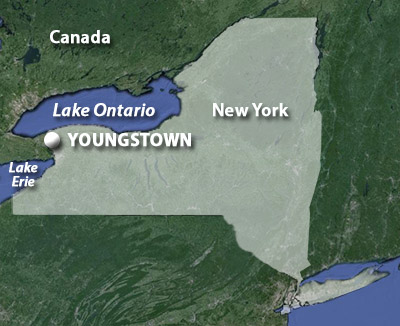 |
|
Fort Conti was built by French explorer Rene-Robert Cavelier (1643-1687) and named for Louis Armand I (1661-1685), Prince of Conti.
By 1687 Fort Conti was no more, mostly owing to the harsh weather that upstate New York enjoys. The Governor or New France, the Marquis de Denonville (1637-1710), led a military expedition to pacify the Iroquois indians by killing them, and built the creatively-named Fort Denonville in order to leave a French presence in the area. Denonville selected 100 soldiers to garrison the fort while he and the rest of his men returned to Montreal for the winter. When he returned in the spring, the Governor found that all but twelve of the garrison had died from disease and/or exposure. Oddly, nobody volunteered to stay another winter at Fort Denonville, so its buildings were pulled down and the site abandoned.
|
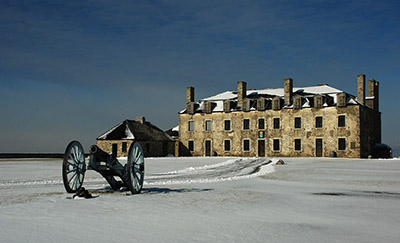 French Castle at Fort Niagara. Don't worry, Seneca Indians, it's not a fort, it's a House of Peace. |
 |
By the mid-1720's, France was ready to try again. The preeminent Indian tribe of the region, the Seneca, said they didn't care what the French built, so long as it wasn't a masonry fort. In 1726, the French got around this restriction by building the Maison a Machicoulis, or "House of Peace," a substantial two-story affair that afforded greater protection against the elements. The structure was so named in order to suggest that peace was desired with those Indians, who persisted in hanging around just because they were there first...but make no mistake, this was a fort that looked like a house, and was also used as a trading post.
|
|
|
King George's War (1744-1748) was the North American part of the European War of the Austrian Succession (1740-1748). The Maison's defenses were increased during this period, edging it towards becoming the masonry fort that the Indians didn't want there...although those same Indians were happy to use the now fortlike Fort Niagara as a staging area for attacks on the British.
Tensions with Britain, which wanted fur and land as much as France did, mounted. The French and Indian War (1754-1763) brought Fort Niagara's strategic location into even sharper focus, and by 1755 the fort, under the direction of Captain Pierre Pouchot (1712-1769), finally attained the sexy starrishness that it exhibits today.
|
Fort Niagara was besieged by the British in July of 1759. Around 2500 French reinforcements had been sent to garrison the fort several months earlier, but most had gone south to Fort Machault to do mean things to the British in Ohio, leaving around 600 troops, including French, Indians and local militia, to guard Fort Niagara.
The British had a force of about 3500, and once they showed up in their overwhelming numbers, 100 Iroquois warriors on the French side said, "later!" and skedaddled. A relief column was put together by the French in Ohio and sent to break the siege, but was defeated just two miles south of the fort at the Battle of La Belle-Famille on July 24, 1759. Fort Niagara surrendered to the British on July 26, 1759.
|
 |
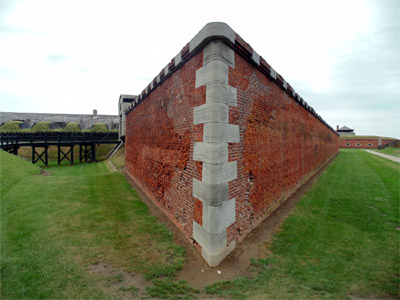 The reinforced, tippy-tip corner of Fort Niagara's southeast bastion. Should you wish to get close enough to this corner to kiss it, as I admittedly do when visiting starforts, you may click here. No judgement. Just starforts. The reinforced, tippy-tip corner of Fort Niagara's southeast bastion. Should you wish to get close enough to this corner to kiss it, as I admittedly do when visiting starforts, you may click here. No judgement. Just starforts. |
|
Indeed the French were pretty effectively routed in the region. The majority of French forces now coalesced at Quebec, which fell to the British in September of 1759. All of New France surrendered in September of 1760, increasing Great Britain's holdings by approximately 2.7 million moose (I made that up).
Fort Niagara was a loyalist base during the American Revolutionary War (1775-1783), serving as the headquarters for Butler's Rangers, a two-fisted British provincial regiment made up of American Tories. Butler's Rangers included a number of former slaves, and may or may not have participated in the Wyoming Valley massacre of July, 1778 and the Cherry Valley massacre of November, 1778, in which primarily white settlers were, y'know, massacred. Fort Niagara became notorious for whoring, gambling and drinking, vices supported by the crude brothels and taverns that popped up south of the fort.
|
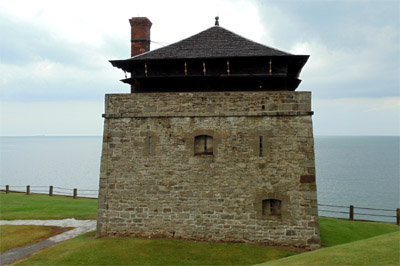 Martello Tower? Heck no, that's Fort Niagara's North Redoubt at the fort's northeast corner, built in 1771. Martello Tower? Heck no, that's Fort Niagara's North Redoubt at the fort's northeast corner, built in 1771. |
 |
Perhaps fortunately for the intoxicated Rangers, the war never made it to Fort Niagara. When the Revolution was concluded with the Treaty of Paris on September 3, 1783, Great Britain technically surrendered all of its holdings in the US, but somehow forgot to depart from Fort Niagara and its surrounding area. Over the next eleven years, the British used this region to grant land to loyalists who had been driven out of their homes by the victorious Americans. The Jay Treaty of November 1794 tied up some of the Revolution's loose ends, one of which being Fort Niagara, which Britain finally turned over to the US in 1796. |
|
|
Since the American Revolution was so much freakin' fun, the US and Britain decided to go back to war on June 18, 1812...which would of course be the War of 1812 (1812-1815). Fort Niagara and Fort George, just across the Niagara River in Canada, celebrated this joyous event by exchanging artillery fire early in the war. On May 27, 1813, American forces captured Fort George, then fanned out to briefly possess the entire Niagara peninsula. British and Canadian forces soon drove them back to Fort George, however, and there they sat. Many of the US troops headed east to participate in a failed attack on Montreal later in 1813, leaving about 200 men, including 100 renegade Canadians, to defend Fort George.
|
US commanders had given the garrison of Fort George orders to burn the nearby Canadian town of Newark (now known as Niagara-on-the-Lake) to prevent the British from seeking cover there, but to burn the town in a kind and thoughtful manner, by giving the townspeople "several days' notice" so as not to leave them homeless and destitute in the snow. Somehow, Newark was put to the torch with no warning whatsoever, dumping its entire unprepared population out into the elements.
Those "renegade Canadians" are said to have had something to do with this, what with their being renegades and all, but doubtless the renegade Canadians blamed the heathen Chinese, who in turn may well have blamed the US commanders who had thought there was a kind and thoughtful way to burn down a town. |
 |
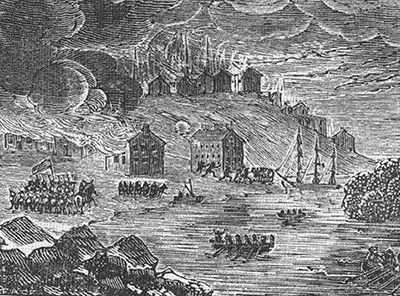 The Canadian town of Newark, needlessly burned courtesy of the US Army: December 10, 1813 |
|
|
Whatever, the defenders of Fort George scattered, leaving Fort Niagara vulnerable to attack. Captain Nathaniel Leonard, a notorious drunkard, was in command of Fort Niagara, which was manned by a small number of mostly wounded or sick men. On December 19, 1813, British regulars under Lieutenant General Gordon Drummond (1772-1854) crossed the river south of the fort and snuck up on its defenders, a British sergeant affecting what was doubtless a perfect southern American accent just long enough to confuse guards, and the British were inside. The fort's defenders holed up in a few buildings and refused to surrender, so the order was given to "bayonet the whole." The defeat of Fort Niagara resulted in only five British dead, and between 65 and 80 American dead. Captain Lewis was captured at his home two miles from the fort, reportedly drunk. The British army burned several villages in the area (including Lewiston, New York) in retribution for the burning of Newark.
|
|
 |
The Treaty of Ghent, signed on December 24, 1814, ended the War of 1812. Fort Niagara was again handed back to the US.
Masonry forts, which did not fare well against artillery, fell out of vogue after the US Civil War (1861-1865). New Fort Niagara, essentially the area outside the walls of what was now known as Old Fort Niagara, became a huge army camp, including a thousand-yard rifle range. Fort Niagara was used to train troops during the Spanish-American War (1898) and the First World War (1914-1918), and during the Second World War (1939-1945) was used as an internment camp for around 1200 German POWs, who had been captured in North Africa.
|
|
|
Like nearby Fort Ontario, Fort Niagara was used as emergency housing for returning US veterans at the end of WW2. The fort served as an anti-aircraft facility during the Korean War (1950-1953), defending the Great Lakes region from North Koreans in their short-range MiG-15's, which would have had to have taken off from Detroit to make it to Fort Niagara. Nike missiles, the US' first operational anti-aircraft missiles, were then stationed at the fort. Fort Niagara was one of the first sites to be designated as a National Historic Landmark in 1960.
Finally the need to defend upstate New York from airborne attack was recognized as unneccessary, so the US Army officially deactivated Fort Niagara in 1963. The US Coast Guard still operates there today, and there are numerous re-enactments of battles, period dances and events that take place at the fort on a regular basis. The Maison a Machicoulis that the French had built in 1726, and that has been known as the French Castle since the 19th century, still stands in the fort.
|
|
|
|
|
|
 |




